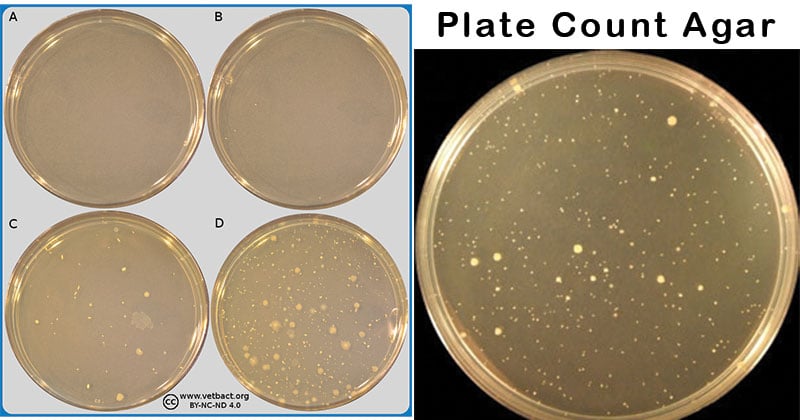Plate count agar (PCA) is a bacteriological substrate used for the determination of the total number of live, aerobic bacteria in a sample. It is not a selective medium. The amount of bacteria is expressed as colony-forming units per gram (CFU/g), in solid samples and per ml (CFU/ml) in liquid samples. The recommended technique is the pour plate technique. The samples are diluted and appropriate dilutions are added in Petri plates. Sterile molten agar is added to these plates and plates are rotated gently to ensure uniform mixing of the sample with agar. The plates are incubated at 20 or 30°C in three days. After incubation, the number of colonies is counted on the plate with 25-250 colonies, which is considered to give the most accurate result. When calculating the actual number of bacteria in the sample, the dilution factor should be taken into consideration.

Interesting Science Videos
Composition of Plate Count Agar (PCA)
| Ingredients | Gms/L |
| Enzymatic Digest of Casein/tryptone | 5.0 |
| Yeast Extract | 2.5 |
| Glucose | 1.0 |
| Agar | 15.0 |
Final pH 7.0 ± 0.2 at 25°C
Preparation of Plate Count Agar (PCA)
- Suspend 23.5 grams in 1000 ml distilled water.
- Heat to boiling to dissolve the medium completely.
- Sterilize by autoclaving at 15 lbs pressure (121°C) for 15 minutes.
- Cool to 45-50°C.
- Mix well and pour into sterile Petri plates.
Principle of Plate Count Agar (PCA)
Plate Count Agar is also called Tryptone Glucose Yeast Agar or Casein-Peptone Dextrose Yeast Agar. The medium contains an enzymatic digest of casein that provides amino acids, nitrogen, carbon, vitamins, and minerals for the growth of the organism. Yeast extract primarily supplies the B-complex vitamins. Glucose is a fermentable carbohydrate and provides an energy source for the growth of bacteria. Agar is the solidifying agent.
Results on Plate Count Agar (PCA)
Count colonies on all plates containing 15-300 colonies. Report the count as CFU/ml for the liquid sample and CFU/g for the solid sample allowing for dilution factors.
Bacillus subtilis = Growth, straw-colored colonies
Escherichia coli = Growth, straw-colored colonies
Staphylococcus aureus = Growth, straw-colored colonies
Uses of Plate Count Agar (PCA)
- Plate Count Agar is used for the enumeration of bacteria in food, water and other materials of sanitary importance.
- It is also suitable for enumerating bacterial count of sterile rooms.
Limitations
- It is recommended that biochemical, immunological, molecular, or mass spectrometry testing be performed on colonies from pure culture for complete identification.
- Plate Count Agar is a general purpose medium and may not support the growth of fastidious organisms.
References
- Himedia
- Neogen Food Safety
- Merck
- Thermo Fisher Scientific Inc.
- Hardy Diagnostics
- Ronald M. Atlas and James W. Snyder (2014). Handbook of media for clinical and public health microbiology. CRC Press. Taylor & Francis Group, LLC.

Nice good